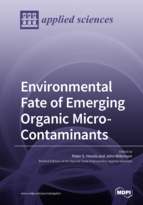Environmental Fate of Emerging Organic Micro-Contaminants
A special issue of Applied Sciences (ISSN 2076-3417). This special issue belongs to the section "Environmental Sciences".
Deadline for manuscript submissions: closed (30 June 2019) | Viewed by 47261
Special Issue Editors
Interests: fate of contaminants in terrestrial and aquatic environments
Interests: environmental fate of micro-organic contaminants, their sources, and dynamics (transportation, transformation/biodegradation, sediment storage, and uptake by aquatic plants and other biota) in river systems
Special Issue Information
Dear Colleagues,
The toxicity and fate of pharmaceuticals and other emerging micro-organic contaminants in the natural and built environments have been the focus of much research over the last twenty years. Recently, particular focus has been centred on the fate of antimicrobial chemicals, including antibiotics and antifungals. The occurrence of such chemicals in the environment is thought to contribute to the selection of resistance in exposed microorganisms. Little is known regarding their persistence through sewage treatment facilities, particularly their partition to sewage sludge or fate in sewage sludge-applied soils. Only recently have minimum selective concentrations for resistance in water been determined for a wide degree of antibiotics. However, little research has been conducted to elucidate whether the concentrations found in various environmental matrices influence the selection of resistance in the environment. The common occurrence of non-antibiotic pharmaceuticals and other micro-organic contaminants (e.g. perfluorinated compounds, plasticisers) is equally of great concern in terms of their environmental fate (occurrence, transformation/biodegradation/attenuation, and bioaccumulation). While the focus of this Special Issue is antibiotics and antifungals, we invite you to submit manuscripts on the environmental fate of all other micro-organic contaminants, particularly in the water-sediment, water-biota, and soil–plant systems.
Dr. Peter Hooda
Dr. John Wilkinson
Guest Editors
Manuscript Submission Information
Manuscripts should be submitted online at www.mdpi.com by registering and logging in to this website. Once you are registered, click here to go to the submission form. Manuscripts can be submitted until the deadline. All submissions that pass pre-check are peer-reviewed. Accepted papers will be published continuously in the journal (as soon as accepted) and will be listed together on the special issue website. Research articles, review articles as well as short communications are invited. For planned papers, a title and short abstract (about 100 words) can be sent to the Editorial Office for announcement on this website.
Submitted manuscripts should not have been published previously, nor be under consideration for publication elsewhere (except conference proceedings papers). All manuscripts are thoroughly refereed through a single-blind peer-review process. A guide for authors and other relevant information for submission of manuscripts is available on the Instructions for Authors page. Applied Sciences is an international peer-reviewed open access semimonthly journal published by MDPI.
Please visit the Instructions for Authors page before submitting a manuscript. The Article Processing Charge (APC) for publication in this open access journal is 2400 CHF (Swiss Francs). Submitted papers should be well formatted and use good English. Authors may use MDPI's English editing service prior to publication or during author revisions.
Keywords
- antibiotics
- antifungals
- microbial resistance
- transformations
- degradation
- attenuation
- bioaccumulation
- wastewater treatment







